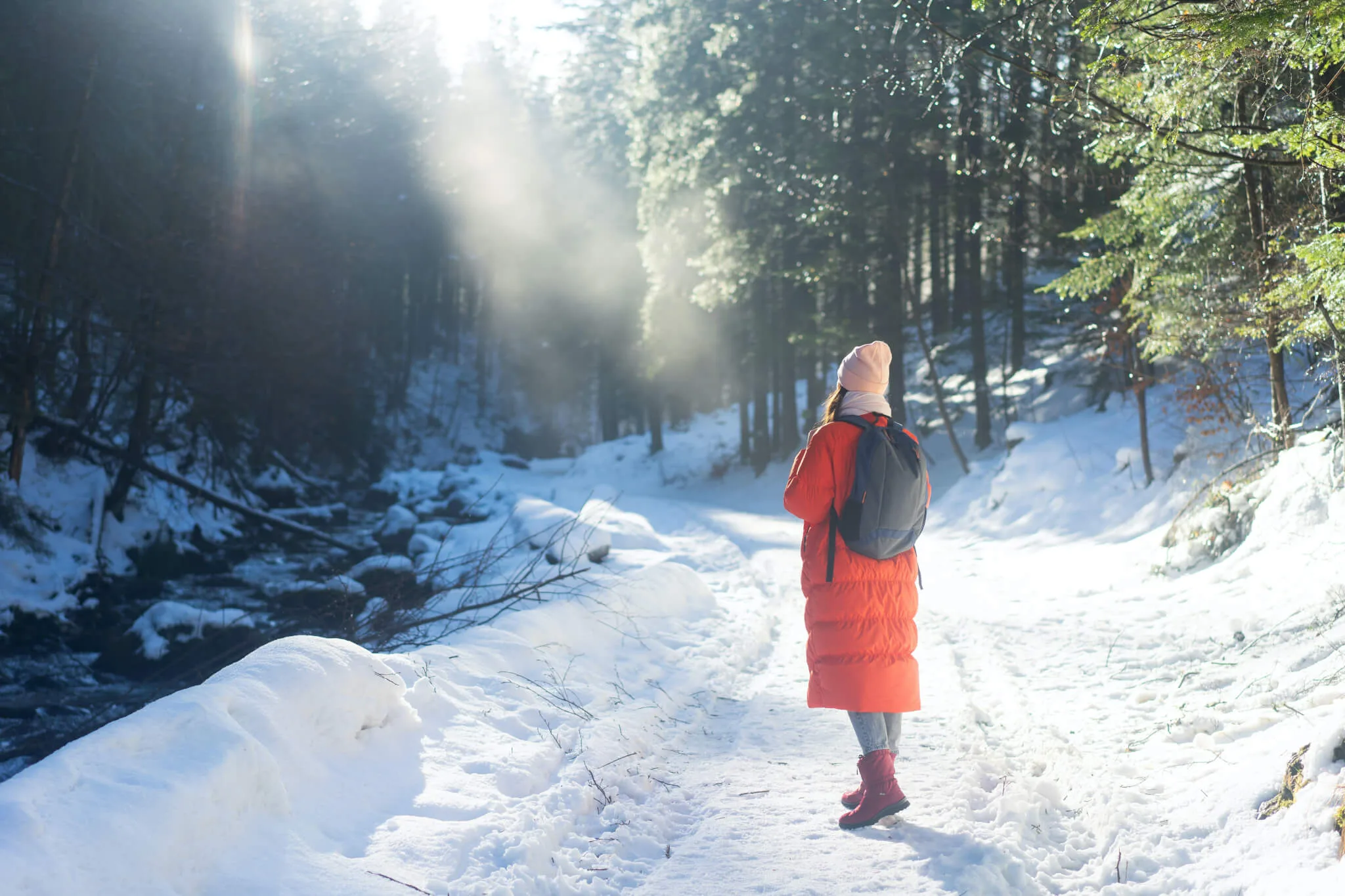
WISCONSIN—A missing teen. An unplowed rural road. A car found in a ditch. Footprints erased by blowing snow. Finally, WSAW out of Brown County, Wisconsin, reported that:
A Brown County Sheriff’s Department statement theorized that the teen, in trying to get her car back on the road, got her shoes full of snow so left them outside the vehicle.
As hypothermia sets in, confusion and impaired judgment are common and reflexes slow down. Shivering, an early sign of hypothermia is involuntary muscle movement the body uses to try to generate warmth. By the time the shivering stops, cognitive impairment and hallucinations can lead to a false sense of warmth and a condition known as paradoxical undressing.
In the late 1980s, I spent one snowy January in New Hampshire doing Wilderness EMT training at SOLO. There, I learned a lot about hypothermia, as well as dressing to avoid it and for general comfort indoors and out when it’s cold. Those lessons and years of living in rural northern Wisconsin contributed to habits and clothing choices deeply influenced by the desire to avoid hypothermia. It’s a common goal in these parts among people who work in outdoor recreation, logging, the trades, with livestock, as volunteer first responders, and making long commutes on snowy rural roads. Most of us have to build wardrobes for extreme conditions one piece at a time. Here are some things that might influence your choice when dressing for cold.
Core vs. Peripheral. The human body is hardwired to protect internal organs located in the head and torso – the core. To help minimize heat loss, it can shunt blood flow to extremities and even to non-essential processes like digestion. That’s part of the reason why the standard of care in emergency medicine is no one is dead until they’re warm and dead. That’s not to minimize the importance of protecting hands and feet from cold. But even those peripherals can feel warmer when you make choices that help conserve heat in the core. Let’s start at the head.
Hats and hoods. The first habit to build is never leaving home without a hat. That includes ladies and gents who think hat-hair isn’t a good look on them. Because heat rises, and the human head is like a stovepipe. Dampering it with a hat or hood is a simple, effective way to hold in heat. For a wide range of cold conditions, consider natural wool yarn, which retains the properties that make it possible for sheep to live outdoors in cold and wet conditions.
Sweat. It’s surprisingly easy to work up a sweat, even in extreme cold. And that can be dangerous because you lose energy as your body works to convert beads of sweat into vapor. So ideally, you want to moderate your activity before the next-to-skin garments protecting your core get damp. The first and simplest way is taking off a hat. If you frequently alternate from strenuous activity to inactive exposure – for example, pulling a sled of ice fishing gear across a frozen lake so you can sit on a bucket with no windbreak while jigging – an ear band can protect ears from frostbite while you’re moving yet let some of that heat rise off.
Layering. Another way to regulate heat and avoid getting sweaty is by dressing in layers. Ideally, that means next-to-skin base layers that wick moisture away from the skin, insulating middle layers that help trap and hold warm air, and outer layers that help prevent evaporative cooling and shed moisture from snow, rain, and splashes. With layers, you can open zippers and/or remove items as needed while you’re post-holing through drifts or climbing to higher ground in search of a cell signal.
Base layers. Synthetic performance fabrics that wick away moisture are popular, and that’s what my husband wears. Some of his base layer pieces are 20 years old. I prefer wool. In addition to wool bottoms and crew neck tops, my wardrobe includes wool and silk camisoles (‘undershirts’ to those of a certain age). Whether I’m dressed up or dressed down, that layer helps keep my core warm.
Cotton. Cotton (including waffle-weave long underwear) isn’t much protection for the core. While it’s wonderfully absorbent it doesn’t wick sweat away from your skin. Instead, cotton holds that moisture and eventually seeps out energy from the body. When you’re wearing cotton as a base layer, be extra cautious about getting sweaty in the warmth of your aging parents’ living room before driving into whiteout conditions on your way home.

Kids. Nevertheless, cotton is a wardrobe staple – especially for children. And kids lose heat more quickly than adults. Their bodies are less able to regulate internal temperature. So they may be losing heat well before they start shivering, let alone sense the cold. It’s important to regulate kids’ activity to avoid getting sweaty or extended exposure in wet or damp clothing – especially when they’re wearing cotton next to their skin.
Mid-layers. These are the layers other people are more likely to see. Workwear, uniforms, team sweatshirts, and other insulating mid-layers can feel a lot warmer over base layer garments that wick moisture away from the skin. My go-to mid-layers are wool sweaters, polyester fleece, hoodies, and vests.
Outerwear. We’re active enough to prefer outer layers that are easy to ventilate, shed and tie around the waist as needed. But many prefer thicker, insulated outer layers. Snow bibs and insulated coveralls aren’t just for kiddos in these parts. Insulated bibs have the advantage of being easy to slip on over clothing suited to warm indoor temps and slip off easily when you head back indoors. I hope someday to acquire a pair of wool bibs overalls like my neighbor has. For now, in winter I mostly wear quick-drying polyester work pants on the bottom and a wind shell over a polyester fleece hoodie on top. Whatever you have, it’s better than nothing so don’t leave home without it. Nobody plans to stand outside waiting for a wrecker, but you can plan to grab what-you-might-need-to-be-safe-in-the-cold every time you head out.
Car seat concerns. A thick, puffy snowsuit under car seat straps can increase the risk of injury to an infant in an impact. There’s good advice here and here on how to choose safe winter outerwear for babies and toddlers.
Feet. At any age, people probably notice discomfort from cold feet long before shivering sets in during the early stages of hypothermia. There are lots of options at many price points for boots that help keep snow out and heat in. Wool socks improve the performance of most. Traction is important, too. Years ago, a delivery driver dressed for winter in Tennessee took one step on our icy northern Wisconsin parking lot and we sent him back to the cab of his truck. His cowboy boots were like dressy office shoes – fine for indoors but outside they can kill you. No matter what you wear to meet a company or personal dress code, make sure there are boots in the car.
Hands. There are aisles of options for handwear at my local farm and fleet store, everything from chore gloves to chopper mitts, insulated and not, thick and thin, convertible (mittens with partial fingers) – even ones with pockets for chemical hand warmer packs. A rough count of my husband’s handwear stash (including hunting gear) turned up 11 pairs. That’s not counting extras stashed in his truck and the ratty mittens he keeps for the rope tow at the local ski hill. All are suited to particular conditions. None perform as needed if they’re in the drawer at home. Our coats all have mittens or gloves in the pockets, and we generally grab an extra pair before heading out the door in case what we’re wearing gets wet or one goes astray.
Elders. Like children, elders’ bodies can have a diminished ability to regulate core temperature. Aging family members and neighbors may become hypothermic even at home and are particularly vulnerable during an extended power outage. Learn more about how to help them here and here. Word of advice: Aged parents can be more stubborn than toddlers and balk at someone telling them how to dress when they’ve been doing it themselves for 80-plus years. In addition, mobility problems can make it hard to get sweaters on and off, and blankets and throws present trip hazards. But in the back of their closet, you might find a vest that’s easy to get on and off and can help keep the core warmer. A neighbor wears a pretty silk scarf around her neck at home to stay warmer except when she vacuums because then she gets too warm.
Dehydration. Dehydration is a common problem in seniors, in winter as well as summer. Inadequate hydration decreases the volume of blood available to circulate oxygen to the extremities. It can happen at any age, though. And what you drink is important, too. A nip of hooch or a caffeinated beverage may produce the illusion of warmth as blood vessels near the skin react. But near the skin is where it’s easiest to lose heat, and the goal is to maintain the body’s core temperature even in cold conditions. That’s best accomplished by drinking enough water throughout the day.
Fueling the furnace. At any age, calories become heat in the human body and eating helps fuel the furnace. One way to feel warmer is by eating a small snack of complex carbohydrates. That’s why it’s recommended to keep snacks in your vehicle in case you get stuck somewhere. But it’s equally important to have access to easy-to-burn calories in your living room if the power is off or the furnace just isn’t keeping up with a cold wind howling through the cracks.
Number 1 Tip. Finally, here’s a tip I learned at SOLO and have shared many times since: If you’re cold, empty your bladder. The energy that’s being used to keep that volume of urine warm in your bladder can be better used elsewhere. It may be hard to believe that peeling off layers to do that is worth the effort, but it works. After peeing, you’ll feel a flush of warmth in your fingers and toes. You may even think a bit more clearly.
Donna Kallner writes from Langlade County in rural northern Wisconsin.
This article first appeared on The Daily Yonder and is republished here under a Creative Commons license.
Politics

SEIU workers ahead of NFL Draft: We are ‘the backbone of Detroit’
BY KEN COLEMAN, MICHIGAN ADVANCE MICHIGAN—A day ahead of the National Football League annual draft being held in Detroit, Service Employees...

Investigator says Trump, allies were uncharged co-conspirators in plot to overturn Michigan election
DETROIT—A state investigator testified Wednesday that he considers former President Donald Trump and his White House chief of staff to be uncharged...

Michigan Dems introduce ‘Child Care for All’ legislation to lower costs for families
Lawmakers say Michigan is facing a ‘child care crisis.’ But a series of bills introduced this month would help to make child care (much) more...
Local News

The 10 best burger joints in and around Lansing
Warning: Do not read this list if you missed lunch or you will find yourself hopping in the car to drive to these best burger joints in Lansing. ...

10 unique wedding venues in Michigan to suit every kind of couple
From a distillery in Detroit to a summer camp, we’ve rounded up some of Michigan’s most unique wedding venues. Of all the elements you need to...





